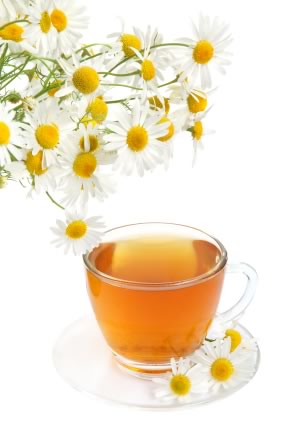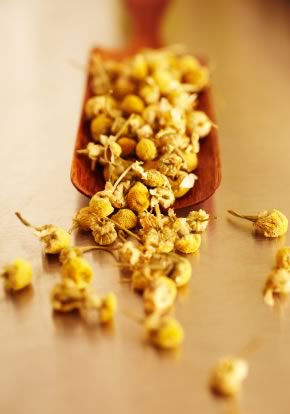Chamomile, known as a popular variety of tea, is actually made up of several different daisy-like plants that belong to the Matricaria genus. The genus Matricaria come from the Latin word matrix which means “womb.” Chamomile plants and can be different species; for example, Roman chamomile, or Chamaemelum nobile, is a different species than German chamomile, or Matricaria recutita. Chamomile is most commonly used as a tea and acts as a sleep aid.
History of Chamomile
Ancient Egyptians admired chamomile for its healing powers and even offered it to the sun god Ra because it was considered so valuable. In ancient Rome, chamomile was used added to drinks for flavor and burned as incense. In Greece, physicians would give chamomile to people with fevers and women with female disorders. German chamomile has been taken as a digestive aid dating as far back as the first century CE. Chamomile was considered so useful by British doctors that they included it in their medical bags both in Great Britain and in the American colonies. Today, chamomile revered for its many medicinal uses.

Myths and Legends
Many cultures thought that chamomile soothed the spirit and would make an unruly spirit gentle and kind. Chamomile was believed to attract love and prosperity and was a common ingredient in potions and concoctions. During the middle ages, chamomile was used as an ingredient in love potions. Gamblers would rub their hands with chamomile as a way to entice money into their pocket. Many cultures believe that if sprinkled around the property, chamomile will rid the home of any evil spirits or curses. It is rumored that Vikings rubbed chamomile on their hair to lighten it and give their hair a blonder appearance.
Description of Chamomile
German chamomile is typically found growing wild in Europe and northwest Asia. In parts of Europe and North America, German chamomile is farm raised so that it can be cultivated and sold for medicinal use. German chamomile is planted in the autumn and harvested in the summer. It is a sweet smelling plant, produces white, daisy-like flowers, and can grow to be over 2 feet tall. German chamomile is the most common variety of chamomile that is used as a sleep aid, burn treatments, and for other medicinal purposes.
Native to western Europe and northern Africa, Roman chamomile has become commercially farmed worldwide in temperate regions. The primary exporters of Roman chamomile are Great Britain, Belgium, France, and Italy. Roman chamomile is an aromatic perennial that produces feathery leaves, white, daisy-like flower with yellow centers, and grows to be approximately 20 inches tall. Just like German chamomile, Roman chamomile flowers are harvested during the summer.
Chamomile? Get Remedies Fast!
Uses of Chamomile
Chamomile is commonly known for its ability to act as a sleep aid. Calming to both adults and children, chamomile does not interfere with activities such as driving or other tasks that require concentration and alertness. It is safe to give to children of any age. Chamomile is ideal for relaxing and calming oneself after a stressful day.
Chamomile is also used to soothe ulcers or other stomach problems that are aggravated by anxiety. Muscle pain, twitching, and muscle spasms that are a result of stress can all be reduced by chamomile because of its ability to relax and calm the body.
Menstrual cramps and sleep disorders related to premenstrual syndrome (PMS) also show improvement with the use of chamomile. Chamomile has been found to contain strong anti-inflammatory and antispasmodic properties that are particularly effective in treating stomach and intestinal cramps. When chamomile is harvested during the early stages of flowering, it can help to relieve gas, bloating, and irritable bowel syndrome. Chamomile also is able to reduce the pain and cramping sensations associated with these stomach ailments.
Clinical Evidence
A German study found that chamomile contains valuable antimicrobial agents. Chamomile is able to rid the body of bacterial toxins and small quantities of chamomile oil have been shown to inhibit staphylococcal and streptococcal strains of bacteria. Drinking chamomile tea combined with other antimicrobial herbs, such as thyme, Echinacea, or goldenseal, reduces the severity of internal infections. Chamomile can also be used topically to treat infections, burns, and inflammation.
Internal Uses
Chamomile tea is so popular among people that it is found in every grocery store aisle. Chamomile tea is used as a mild sedative, helps to relieve insomnia, eases the pain of teething for young children, and relieves many stomach pains. Additionally, drinking chamomile tea regularly has been shown to reduce pain associated with arthritis and other painful inflammations. Large doses of chamomile tea can reduce the severity of symptoms associated with colds and flu such as fever, sore throats, and chills.
External Uses
Chamomile is often infused with other natural ingredients in shampoos and conditioners. Hair products containing chamomile leave hair feelings moisturized, not heavy, and very manageable. Dried chamomile is found in potpourri, herb therapy, and aromatherapy. The dried chamomile found in these helps to relax and calm the body and relieves it from stress. Chamomile can be applied to the skin to relieve sunburns, aching muscles, and mild burns. Often, chamomile is found in cosmetics as an anti-allergenic agent. Unused chamomile tea is can be given to plants as a liquid feed and plant tonic. Chamomile has been shown to be quite effective against a number of plant diseases. Many perfumes are made from an essential oil derived from chamomile. Dried chamomile flowers can even act as an insect repellant.

Dosage
There is no universal dosage method for chamomile. Studies have shown that consuming ½ to 3 drops of chamomile essential oils to be beneficial as a sleep aid and to help ease stomachaches and cramps. Teas can be consumed safely one to four times a day. When using chamomile ointments, it is recommended that they contain 3% to 10% chamomile for best results.
Side effects
Chamomile is considered one of the safest herbs and has little side effects. A potential side effect associated with drinking chamomile tea is drowsiness. Because chamomile tea can be used as a sleep aid, drowsiness is always a possibility. Those who are allergic to ragweed pollen or have hay fever may have an allergic reaction to chamomile. Moderation is key with chamomile to avoid any adverse reactions. In some individuals, high doses of chamomile may cause vomiting and skin irritations. Do not use chamomile if pregnant. Chamomile was once used as a mixture of herbs to induce abortions during the middle ages. Those who are on blood thinners also avoid taking chamomile. Studies have suggested that chamomile has an ability to thin the blood by containing properties such as coumarin, which act as blood thinners.
Home Remedies
Stomach Cramps
Prepare a cup of lightly sweetened chamomile tea. Drink the tea twice a day, once in the morning and once in the evening, until symptoms are gone.
Insomnia
30 to 45 minutes before bedtime, make a strong cup of chamomile tea. Drink the tea and get ready for bed as usual.
Chamomile bath
A chamomile bath can relieve many ailments such as colds, stress, PMS, and itchy skin. There are several ways to prepare a soothing chamomile bath. Place ½ to 1 cup fresh or dried chamomile tied in linen bag and place it in the hot tub water. Let the bag soak for at least 10 minutes. Remember, do not add soap to bath. Another way to create a relaxing chamomile bath is to combine 10 to 20 drops of chamomile essential oil in with bath salts to the bath water.
Burns and Scrapes
Rub a small amount of chamomile essential oil gently across the burned or scraped area once a day. Another treatment for burns and scrapes is made by brewing 3 chamomile tea bags to one cup of water. Once the water has cooled, dip a clean cloth into the tea and use it as a compress on the affected areas.
Dark Circles
A simple remedy for reducing the appearance of dark circles is to dip 2 chamomile tea bags in warm water. After 5 minutes, remove the tea bags from the water and allow to cool until room temperature. Once cooled, place the teabags on the eyes at night as a compress.
Where to Purchase Chamomile
Chamomile teas are available in the tea aisle at most grocery stores. One of the most popular selling brands of chamomile tea is Celestial Seasonings. Celestial Seasonings can be found at Walmart, Target, Walgreens, as well as many health food stores for approximately $4 for a box of 20 tea bags or online at drugstore.com. Chamomile can be also be purchased in the forms of dried flower heads, liquid extract, essential oil, or in creams and ointments.
Many health food stores carry dried chamomile as well as online websites such as www.herbspro.com. Dried chamomile typically sells for $9 a pound at health food stores or online at www.americanspice.com. Liquid extracts and chamomile essential oils are found at health food chains such as Whole Foods. These products tend to me more expensive. Essential oils sell for approximately $15 for a .5 ounce vial and liquid extracts sell for $11 at The Vitamin Shoppe or online at amazon.com.

1 Comment
THANK YOU! I will see if it works for me, I’m just glad to get some type of help.